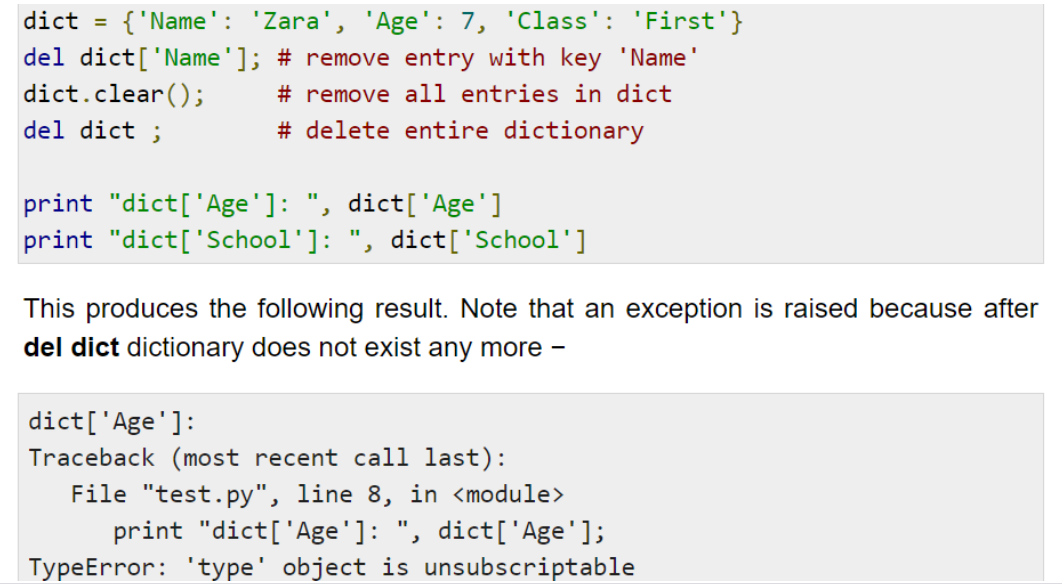Python数据处理必备:字典嵌套列表的清洗与分析全攻略
发布时间: 2024-09-11 23:11:35 阅读量: 133 订阅数: 45 


# 1. Python数据处理基础
Python 作为一种编程语言,其简洁优雅的语法深受开发者喜爱,尤其在数据处理方面表现出色。在本章节中,我们将展开讨论 Python 数据处理的基础内容,包括 Python 中常用的数据结构,字典和列表的基本操作,以及数据处理过程中常用的库。
## Python中的数据结构概述
Python 中最常用的数据结构包括列表(list)、字典(dict)、集合(set)和元组(tuple)。这些数据结构各有特点:列表是有序的,字典是无序且键值对的,集合是无序的且元素唯一,元组是不可变的。掌握这些基础是进行数据处理的前提。
```python
# 示例:创建列表和字典
my_list = [1, 2, 3, 'Python']
my_dict = {'name': 'Alice', 'age': 25}
```
## 字典和列表的基本操作
字典和列表是 Python 数据结构中非常重要的部分。它们的基本操作包括创建、索引、增加、删除和修改等。理解这些操作对于后续的数据处理至关重要。
```python
# 列表操作示例
my_list.append(4) # 增加元素
print(my_list[0]) # 访问第一个元素
# 字典操作示例
my_dict['gender'] = 'Female' # 增加键值对
print(my_dict.keys()) # 获取所有键
```
## 数据处理的常见库介绍
Python 提供了丰富的库用于数据处理。其中 `pandas` 是最常用的数据处理和分析库,它提供了 `DataFrame` 和 `Series` 两种主要的数据结构。其他如 `numpy` 用于数值计算,`matplotlib` 和 `seaborn` 用于数据可视化等。
```python
# 导入 pandas 库并创建 DataFrame
import pandas as pd
data = {'Column1': [1, 2, 3], 'Column2': ['A', 'B', 'C']}
df = pd.DataFrame(data)
```
通过掌握这些基础内容,我们可以为深入学习数据处理和分析打下坚实的基础。在接下来的章节中,我们将进一步探讨数据结构的高级操作和数据清洗的技巧。
# 2. 字典与列表的高级操作
## 2.1 字典的高级应用
### 2.1.1 字典的嵌套使用
在处理复杂的数据结构时,字典的嵌套使用是非常有用的。这允许我们将相关联的数据组合在一起,并在查找时拥有更多的维度。例如,在一个用户信息系统的字典中,我们可以存储用户的个人资料信息以及用户账户的详细信息。
```python
user = {
'profile': {
'name': 'Alice',
'age': 25,
'email': '***'
},
'account': {
'username': 'alice123',
'signup_date': '2021-05-15',
'last_login': '2021-08-20 12:30'
}
}
```
在上述字典中,我们可以简单地通过`user['profile']['name']`来获取用户的姓名。这种结构清晰且易于维护。
### 2.1.2 字典的常用操作方法
Python字典提供了许多内置方法,以支持各种操作。一些常用的字典方法包括`.get()`, `.pop()`, `.keys()`, `.values()`, `.items()`, `.update()`等。
- `.get()`方法允许在访问字典键时避免`KeyError`异常。例如,`user.get('age', 'No age found')`会在`'age'`不存在时返回默认值`'No age found'`。
- `.pop()`方法用于移除字典中的某个键并返回对应的值,如果键不存在则返回默认值。它也常用于弹出最后一个插入的项,通过指定`popitem()`。
- `.keys()`, `.values()`, `.items()`分别返回字典的键、值和键值对的视图,可以用于遍历字典。
```python
for key in user.keys():
print(key, user[key])
for key, value in user.items():
print(f'{key}: {value}')
```
- `.update()`方法可以用来更新字典中的一项或者添加一个新的键值对。
了解并熟练使用这些字典操作方法可以大大提高我们处理数据的效率。
### 2.1.3 字典的高级功能:动态属性访问
在Python中,虽然字典是通过键值对来存储数据,但也可以通过`__getattr__`和`__setattr__`魔术方法实现类似对象属性的访问。
```python
class AttrDict:
def __init__(self, *args, **kwargs):
super(AttrDict, self).__setattr__(*args, **kwargs)
self.__dict__ = self
def __getattr__(self, item):
try:
return self.__dict__[item]
except KeyError:
raise AttributeError(item)
def __setattr__(self, key, value):
self.__dict__[key] = value
user = AttrDict(name='Alice', age=25)
print(user.name) # Alice
```
在此类`AttrDict`类的帮助下,您可以像访问对象属性一样访问字典的键,这为字典提供了一种更动态的访问方式。
# 3. 嵌套结构的数据清洗
## 3.1 数据清洗的基本原则与方法
### 3.1.1 清洗流程概述
数据清洗是数据预处理的重要步骤,旨在提高数据的质量。一个合理的清洗流程包括识别数据问题、评估影响、清洗数据并验证结果。在处理嵌套结构数据时,需要先理解数据的整体架构和嵌套的层级关系。
对于嵌套数据结构的清洗,首先需要明确数据中的嵌套层级关系,例如嵌套的字典、列表或混合结构。每个层级都可能需要不同的清洗方法,例如:
- **字典清洗**:处理嵌套字典中的重复键、合并相似键值对或去除无效键。
- **列表清洗**:处理重复元素、排序、过滤不符合条件的元素。
在清洗流程中,应该遵循以下步骤:
1. **数据探索**:使用Python进行初步的数据探索,了解数据的分布、类型和结构。
2. **问题识别**:通过数据探索确定需要处理的数据问题,如缺失值、异常值等。
3. **策略制定**:制定解决方案,如填充缺失值、删除异常记录或转换数据类型。
4. **数据清洗**:执行清洗策略,使用Python进行数据修改。
5. **验证与复核**:确保清洗后的数据符合预期,并进行必要的测试。
清洗流程的逻辑可以用Python代码块进行演示:
```python
import pandas as pd
# 加载数据
data = pd.read_csv('data.csv')
# 数据探索
print(data.head())
# 问题识别
missing_values = data.isnull().sum()
# 策略制定
# 例如,对于数值型数据,我们使用平均值填充缺失值
data['numeric_column'] = data['numeric_column'].fillna(data['numeric_column'].mean())
# 数据清洗
data = data.dropna() # 删除含有缺失值的行
# 验证与复核
print(data.isnull().sum()) # 确保没有缺失值
```
### 3.1.2 缺失值处理
在数据清洗中,处理缺失值是一个常见的任务。缺失值可以出现在任何数据集中的任何位置,而且有多种处理方法,如删除、填充或估算。对于嵌套结构的数据,处理方法需要根据上下文具体分析。
- **删除含有缺失值的记录**:如果缺失值不多,直接删除这些记录可能是简单有效的方法。
- **填充缺失值**:根据数据的特性选择合适的值来填充,如平均值、中位数、众数或者基于其他列的预测模型。
在Python中,使用Pandas库来处理缺失值如下:
```python
# 删除缺失值
data_cleaned = data.dropna(how='any') # 删除含有任何缺失值的行
# 填充缺失值,使用列的平均值填充
data_filled = data.fillna(data.mean())
```
### 3.2 嵌套数据结构的清洗技巧
#### 3.2.1 嵌套字典与列表的清洗技巧
处理嵌套字典和列表时,主要关注点在于数据结构的层级和复杂性。这通常需要递归函数来处理不同层级的数据。
- **递归处理嵌套字典**:针对嵌套字典,可以编写递归函数遍历每个层级的键值对,执行清洗任务。
- **递归处理嵌套列表**:针对嵌套列表,可以编写递归函数处理列表中的每个元素,无论是列表还是字典。
下面是一个递归函数来处理嵌套字典的例子:
```python
def clean_nested_dict(d):
for key, value in d.items():
if isinstance(value, dict):
clean_nested_dict(value) # 递归调用
elif isinstance(value, list):
for item in value:
if isinstance(item, dict):
clean_nested_dict(item) # 递归调用
else:
#
```
0
0





